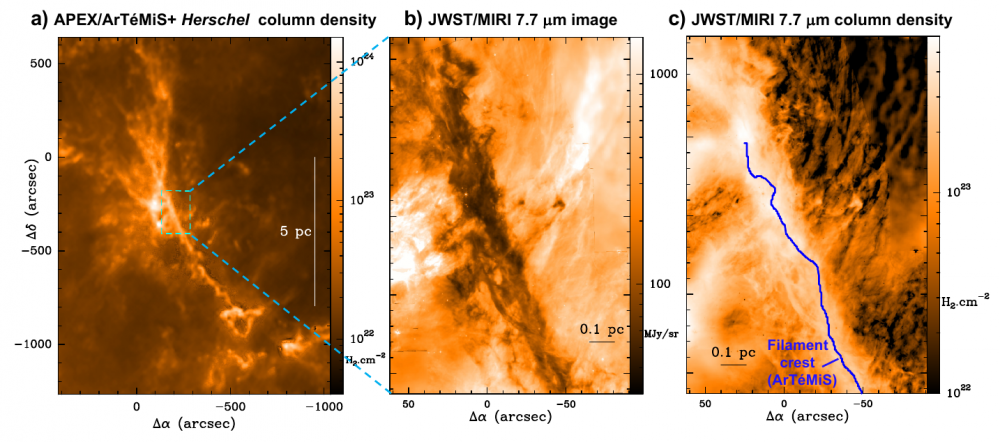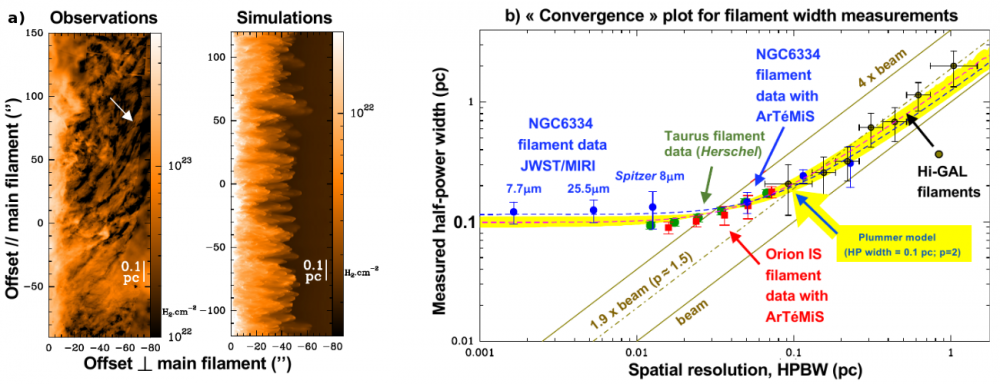Follow us on Google News (click on ☆)
These observations allow for the first precise measurement of the width of an interstellar filament, a site of star formation, beyond the Gould Belt, and confirm the existence of a characteristic scale of ≈0.1 pc (≈0.33 light-years). This result provides a better understanding of why stars do not form with arbitrary masses.

a) Column density map of the massive star-forming cloud NGC6334 at an 8” resolution, produced from combined ArTéMiS and Herschel data as part of the CAFFEINE program.
b) JWST/MIRI image of a portion of the field shown in a), revealing the fine structure of the filament NGC6334M at a resolution of 0.26” in absorption at 7.7 microns.
c) High-resolution (0.26”) column density map derived from JWST/MIRI absorption data in panel b).
This study has been published in the journal Astrophysical Journal Letters.
Understanding the complex growth of structures leading to star formation in the cold InterStellar Medium (ISM) of galaxies is a central question in astrophysics. At least to first order, the structure of cold interstellar clouds is observed as scale-free or self-similar, in the sense that all images of molecular clouds tend to be statistically similar, regardless of the spatial resolution at which they are obtained.
This self-similarity is often attributed to the effect of supersonic turbulence shaping the structure of molecular clouds. A fundamental open question is therefore understanding how stars, which are finite-sized bodies, can emerge from a scale-free ISM, with a birth mass distribution (called the Initial Mass Function, or IMF) exhibiting a broad peak around 0.3 M☉, just below the mass of our own Sun.
Submillimeter observations of nearby molecular clouds by the Herschel space observatory have provided important clues to this question, showing that most stars are born in dense filaments of cold gas at temperatures around 10 K.
At least in the solar neighborhood, Herschel observations indicate that star-forming filaments all have roughly the same width, close to about 0.1 pc (≈0.33 light-years). When these filaments reach a critical mass per unit length of about 16 M☉/pc, they can fragment and form stars with a characteristic mass approaching 0.3 M☉, the observed peak of the IMF.
However, the Herschel telescope could only resolve the ≈0.1 pc scale by a relatively modest factor in the nearest clouds and could not probe the structure of star-forming filaments in more distant clouds beyond the Gould Belt, i.e. the solar neighborhood. Consequently, the robustness and scope of the above explanation for the origin of the IMF peak have been questioned.

a) Comparison of a close-up view of the northwestern part of panel c in the first figure (rotated 20 degrees clockwise to align the main filament with the y-axis) with recent MHD numerical simulations of the formation and evolution of a massive star-forming filament. Both observations and simulations show a quasi-periodic pattern of lateral filaments (one marked by a white arrow in the left panel), with a projected spacing of about ~0.1 pc.
b) Convergence plot showing the measured width as a function of spatial resolution for NGC6334M and other filaments observed with Herschel and APEX/ArTéMiS. Note how the measured widths converge to a value of about 0.1 pc when this scale is resolved by a factor of about 10.
To study the properties of dense filaments and their potential role in the origin of stellar masses beyond nearby clouds, our team used the JWST's MIRI instrument at 7.7 and 25.5 μm, as well as the ArTéMiS camera on the APEX telescope, to image the massive filament NGC6334M (at about 1.3 kpc) and its surroundings at a resolution one to two orders of magnitude better than Herschel. Filaments like NGC6334M are so cold and dense that they do not emit significant light at mid-infrared wavelengths but are seen as dark silhouettes by MIRI, in absorption against the infrared background emission (cf. figure).
JWST absorption data revealed the fine structure of the NGC6334M filament with unprecedented detail. A median filament width of 0.12±0.02 pc was measured at both MIRI wavelengths, resolved by nearly two orders of magnitude by JWST, and consistent with the typical half-power width of Herschel filaments in nearby molecular clouds.
JWST data also revealed a quasi-periodic pattern of lateral filaments with a similar projected spacing of 0.125±0.015 pc (cf. panel c of the figure). Recent magnetohydrodynamic numerical simulations are able to reproduce this characteristic scale and quasi-periodic pattern (cf. panel a of the figure below).
The existence of this characteristic scale of ≈0.1 pc demonstrates that star-forming molecular clouds are not strictly scale-free and supports the suggestion that the IMF peak at ≈0.3 M☉ may be intimately linked to the filamentary structure of the cold ISM.
Reference: "Structure and Fragmentation Scale of a Massive Star-Forming Filament in NGC6334: High-Resolution Mid-Infrared Absorption Imaging with JWST" Ph. André, M. Mattern, D. Arzoumanian et al. 2025, The Astrophysical Journal Letters, in press (DOI, arXiv).